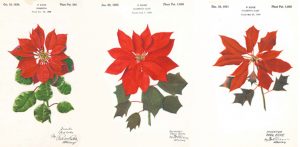U.S. Plant Patent
Many of us associate the holiday season with Poinsettia Plants. However, few people realize that it was covered by a plant patent for over a hundred years. Like the poinsettia plant, its history, is colorful and interesting. It also provides an example of how valuable a patent can be, namely, Plant Patents.
The Poinsettia was introduced into America from Mexico in 1828 by Dr. Joel Roberts Poinsett, after whom the plant was named. From an economic standpoint, it is estimated that annual poinsettias sales are greater than $250 million with more than $60 million typically occurring during the six-week period near Christmas. The poinsettia plant has been referred to as the most popular potted plant in America.
Poinsettia’s history dates back to the Aztecs. In fact, Montezuma, the last of the Aztec Kings, like the plant so much that he adorned his palaces with the plant and used its red leaves as dye in his fabrics and its leaves and stems for medicine to treat fever, stimulate breast milk production, and to terminate pregnancies. Its latex (the milky fluid in the stem) can be used to kill pain, kill bacteria, and cause vomiting.
When it comes to patents most people think of utility patents. A utility patent provides a form of monopoly for new and useful processes, machines, manufactures, compositions of matter, or any new and useful improvement thereof.
While most patents are utility patents, there are two other types of patents. Design Patents which are on the rise and Plant Patents. A plant patent may be provided to an inventor who has invented or discovered a plant (not a potato, root or tuber) and is able to reproduce a distinct and new variety of the plant through asexual reproduction. “Asexually reproduce,” means that the plant is reproduced without the use of seeds, usually by cutting or grafting the plant although there are other ways including division, slips, rhizomes, and root cutting, among others. The patent grant under plant patents, lasts for 20 years from the date of filing the application and provide a form of monopoly right, allowing the inventor to exclude others from asexually reproducing, selling, or using the plant reproduced. Since the Plant Patent Act of 1930, more than 23,000 U.S. plant patents have issued.
At Intellectual Property Center, we hope you have a Happy New Year. Feel free to call tel:+1-913-345-0900 or email us to schedule a meeting with one of our attorneys to discuss ways to protect your invention or extend your intellectual property protection with a patent attorney.

